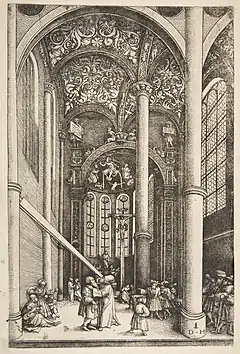Matthew 7:5
Matthew 7:5 is the fifth verse of the seventh chapter of the Gospel of Matthew in the New Testament and is part of the Sermon on the Mount. This verse continues the discussion of judgmentalism.
| Matthew 7:5 | |
|---|---|
← 7:4 7:6 → | |
 Daniel Hopfer's "the Parable of the Mote and the Beam" (c. 1530). Interior of the Church of Saint Katherine's. | |
| Book | Gospel of Matthew |
| Christian Bible part | New Testament |
Content
In the King James Version of the Bible the text reads:
- Thou hypocrite, first cast out the beam out of thine own eye;
- and then shalt thou see clearly to cast out the mote out of thy brother's eye.
The World English Bible translates the passage as:
- You hypocrite! First, remove the beam out of your own eye, and then you can see clearly to remove the speck out of your brother’s eye.
For a collection of other versions see BibleHub Matthew 7:5
Analysis
This verse continues the metaphor of a person with a plank in their own eye who criticizes someone for a speck in that person's eye. In this verse, Jesus argues that one must first remove the plank before going on to remove the speck. This verse makes clear that it is the height of hypocrisy to point out a minor flaw (sin) in another when your sins are much worse. Jesus always made clear that judging was to be done by the Father, and humans should concern themselves with making their own soul ready for acceptance into the kingdom of God. The focus should always be in one's own faults, not their neighbor's. Such aid should only be given, however, once one's own much larger problems are dealt with. Seeing that humans are always fallible, your own salvation and righteousness should be your focus, not finding fault with others. [1]
The implication is that it is impossible for one to ever completely clear away their own flaws, and thus the opportunity to begin judging others will never arise. Hill sees this statement as in the same spirit as the famous "He who is without sin" teaching of John 8:7.[2]
Uses
Composer Georg Philipp Telemann[3] uses this verse together with Psalm 139:11–12, and John 8:7 as the text in his cantata, Vor des lichten Tages Schein, TWV 1:1483 (Harmonischer Gottes-Dienst, Hamburg 1726.[4][5]
References
- Luz, Ulrich. Matthew 1-7: A Commentary. trans. Wilhelm C. Linss. Minneapolis: Augsburg Fortress, 1989.
- Hill, David. The Gospel of Matthew. Grand Rapids: Eerdmans, 1981
- "3è dimanche de l'Avent" section at Georg Philipp Telemann, Catalogue TWV 01: Cantates d'église, Temps de l'Avent (www
.musiqueorguequebec ).ca - (in German) Der Harmonische Gottesdienst, Texts at www
.mibacom .de /downloads / - Toccata Classics. Liner notes to Georg Philipp Telemann: Harmonischer Gottes-Dienst – Hamburg, 1725–26, Vol. 4. 2012.
| Preceded by Matthew 7:4 |
Gospel of Matthew Chapter 7 |
Succeeded by Matthew 7:6 |